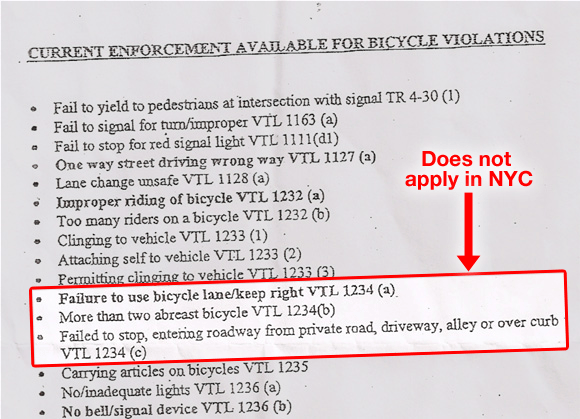Sometime between the ticket one cyclist received for turning right on red into Central Park and the ticket another received for riding with a bag slung over her handlebars, it became abundantly clear that NYPD's "Operation Safe Cycle" is not really about safer cycling. Instead of applying the NYPD's vaunted data-driven policing techniques to encourage safer and more courteous cycling behaviors, the department's bike blitz seemingly consists of harassing cyclists and slapping them with large fines for the most minor transgressions.
In some cases, the fines are for non-existent violations. A cheat sheet circulated by police [PDF] indicates the department isn't even limiting its bike enforcement to the offenses on the books.
According to reliable sources who obtained the sheet from police, the document was distributed by NYPD in February to assist officers in the bike ticketing blitz. The cheat sheet includes three violations that don't apply in New York City, even though federal judges have made it plain to the NYPD on more than one occasion that such citations are bogus.
The sheet tells cops they can issue tickets for violating sections 1234 (a), (b), and (c) of the state's vehicle and traffic law, which require cyclists to either ride in a bike lane or along the right side of the road, to ride no more than two abreast, and to come to a stop before turning onto a road from a driveway. None of those rules, however, apply in New York City.
"VTL 1234 is a section of the state vehicle and traffic law that New York City was given the authority by the state legislature to supercede," explained attorney Mark Taylor [disclosure: Streetsblog has retained Taylor's firm for unrelated legal assistance managing freedom of information requests]. Just as New York City was able to ban drivers from making right turns on red, it was able to replace the requirements of VTL 1234.
While it's a bit confusing that VTL 1234 doesn't apply in New York City -- you have to look in an entirely different legal code to find that out -- the NYPD is intimately aware of which rules they can enforce in this case. "They have repeatedly been in front of courts and forced to admit that 1234 does not apply in New York," said Taylor. "It has been very clear to the NYPD for a long, long time, so the idea that they are continuing to issue instructions to officers on the street to promulgate these laws that don't apply in NYC is just amazing."
The inclusion of an invalid law on the NYPD's cheat sheet suggests that the bike blitz isn't so much about enforcing the law, right or wrong, but an intentional campaign to make life more difficult for cyclists. A judge would quickly throw out any section 1234 ticket written in New York City, said Taylor.
It is not known how widely this document was distributed within the police department, nor if other guides to ticketing cyclists are in circulation. One traffic cop I spoke with at the corner of Crosby and Spring Streets in SoHo said he had never seen this document or anything similar, suggesting it isn't in use citywide. Streetsblog has asked the NYPD press office to explain the document and received no reply.
NYPD has a track record of using cheat sheets that lead officers to issue wrongful summonses, and prior cases suggest that the department can be held accountable if supervisors encouraged officers to crib from the bike enforcement sheet. A federal judge found last year, for example, that the NYPD's continued use of unofficial cheat sheets listing unconstitutional loitering statutes was evidence of the department's "lax approach" to stopping that variety wrongful enforcement. So long as any supervising officers are aware of the cheat sheets, that case suggests, the department is to some degree responsible for the decision to knowingly enforce an inapplicable law.
It's also plausible that this cheat sheet is responsible for the farcical arrest of a school administrator for carrying her totebag on her handlebars, an action which is perfectly legal. The sheet summarizes VTL 1235 as "carrying articles on bicycles," a description which, to an officer without sufficient training, would seem to apply in this case. The full law clearly states otherwise, however: It prohibits carrying objects in such a way that cyclists can't keep at least one hand on the handlebars. If a single sheet of paper is the extent of the instruction some officers are receiving before being sent out to ticket cyclists, then such improper summonses will inevitably be issued.






